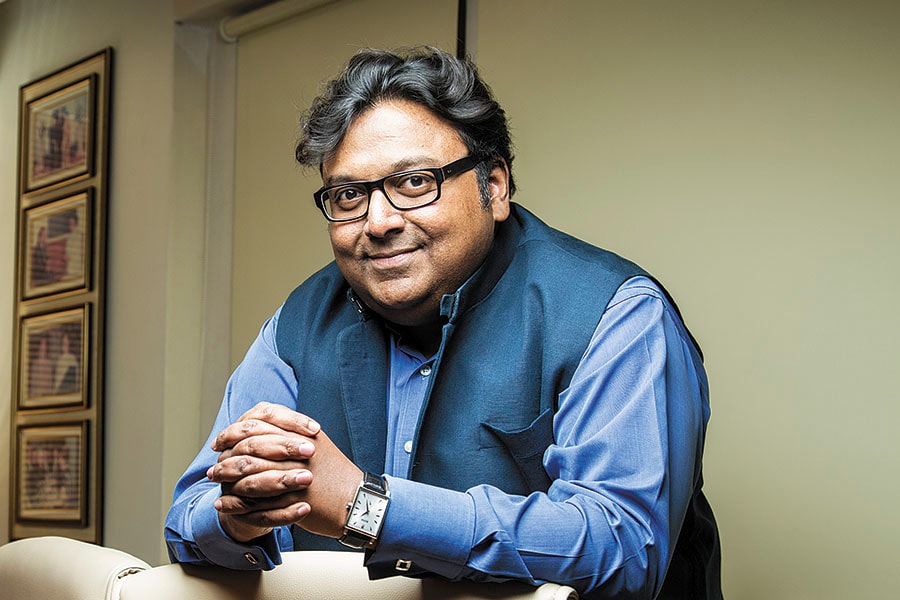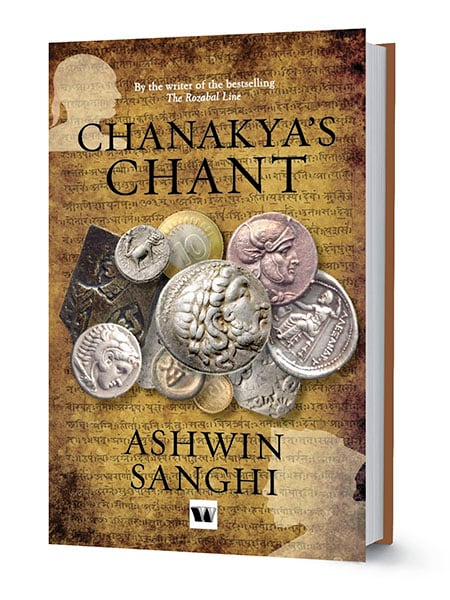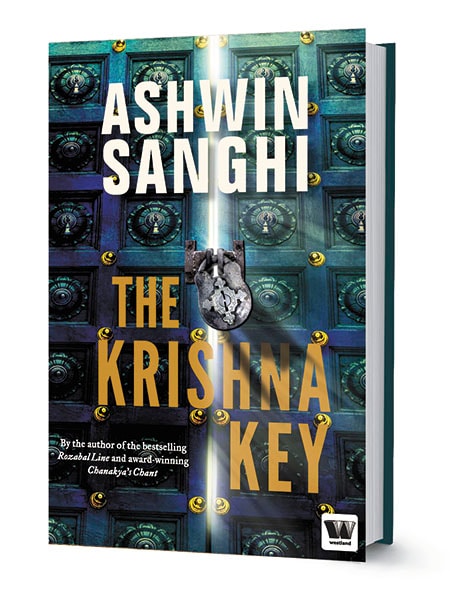Writer Ashwin Sanghi's 'bloody good' business model
After 10 years of penning thrillers, author Ashwin Sanghi is shifting gears to explore non-fiction

It is 11.30 am but the Vitesse Maruti Suzuki showroom opposite Nehru Centre, in Worli, Mumbai is alive with the sound of customers. It is the first day of Diwali—and still a pre-demonetisation world—and salesmen are unflaggingly pitching cars to interested families.
We walk through the buzz and climb a few stairs up to a mezzanine floor. A smiling Ashwin Sanghi opens the door and ushers us into his tidy cabin. His desk has a few copies of his latest book, 13 Steps To Bloody Good Wealth, released in October 2016.
Before we start our chat, he orders coffee and makes sure he gets a double dose of sugar. “I’m not the best person to write on health,” laughs Sanghi good-naturedly. “But I am, actually, working on a book in my 13 Steps series which talks about how to keep fit and maintain good health,” he says, taking a sip of his much-sweetened beverage. The 13 Steps to Bloody Good Health, up for release in late 2017, is in collaboration with a health specialist, he quickly reassures.
This will be the third edition of his 13 Steps series. In 2014, the 47-year-old had released the first—13 Steps To Bloody Good Luck, a book comprising quick tips to achieve success and beat bad luck, drawn from his experiences—which had proved successful with managers. He followed that up with 13 Steps to Bloody Good Wealth, which also became a bestseller. “This book is an engaging and insightful account of lessons learnt as the authors [Sanghi co-wrote this with Sunil Dalal; more on that later] managed their own money, made mistakes and emerged wiser. It is recommended reading for anyone—students, housewives, professionals and savvy investors—who wants a primer for growing their wealth through the cycle of life,” says Leo Puri, managing director, UTI Asset Management.
Self-help is far from the world of crime and mythology that Sanghi found his author feet in. In the decade since he finished writing his first novel, The Rozabal Line, he has made a name for himself as a prolific thriller writer. Since 2007, Sanghi has published eight books —six have been in the crime and mythology genres while two (in the 13 Steps series) are non-fiction.
His novel Private India: City on Fire co-written with best-selling American author James Patterson, came out in 2014 and became an international bestseller. More importantly, Sanghi’s experience with Patterson, the highest-paid writer in the world according to Forbes, earning $95 million in 2016, also gave him a glimpse into the profitable world of collaborative writing.
Over the years, Patterson has built an effective practice of lending his brand to new authors; they leverage his popularity and Patterson earns royalty. This model made business sense to Sanghi. “What James Patterson has done with fiction, I would like to do with non-fiction,” he says. “I’m not aspiring to be Patterson because, frankly, it would take years and years to try and reach that. What I’m trying to do is take the best ideas of people who have worked for years in their respective fields, which are complex in nature, and turn them into simple, easy-to-understand books.”
The 13 Steps books are his first attempt at this model. He published 13 Steps To Bloody Good Wealth with Sunil Dalal, a childhood friend and serial entrepreneur who also runs financial technology company Asset Vantage. “Sunil understands asset management. And my job was to communicate the ideas of money management in a simple way. So we worked together,” says Sanghi.
“I was a bit apprehensive when Ashwin asked me if I would co-author a book on wealth given that I was not a professional money manager. But he was looking for a different point of view and someone who could make the complex subject of wealth simpler,” says Dalal. Sanghi is similarly tying up with experts in the education, communication and even parenting sectors.
While it all seems to have worked according to plan for one of India’s highest-earning authors, it wasn’t without the storybook struggle. In fact, it was his struggle to become a published writer that was also the basis for his 13 Steps To Bloody Good Luck.
Sanghi’s first book The Rozabal Line, faced rejection from a lot of publishers—a fact he almost wears with pride
Writer’s WoesIn 2006, after he wrote The Rozabal Line over two years, Sanghi faced rejection across the board—a fact he almost wears with pride, and which even finds mention on his website. It was a period when Indian publishers were looking for literary superstars of the Arundhati Roy and Jhumpa Lahiri ilk.
Sanghi figured he could step into the Robert Ludlum space in the Indian context. However, at the time, most publishers operating in India were multinationals, with parent companies based out of New York or London. For them, there was no need to look for an Indian Ludlum as the original Ludlum himself was popular here.
Also, the international market wanted fiction with literary tropes that were quintessentially Indian. “I approached over 150 publishers and agents in India and abroad, and most of them sent me rejection notes,” he says. As inspiration, he had even put up a card on the wall opposite his desk, which mentioned the number of rejections that JK Rowling, Margaret Mitchell and Stephen King received before they finally managed to get published.
Sanghi knew he needed patience. But he also knew he needed enterprise. It was ingrained in his businessman genes and MBA education. Sanghi is the son of Mahendra Sanghi, whose business interests include the automobile dealership franchise Vitesse. Ashwin Sanghi himself had done his MBA in finance from Yale University in 1993.
After returning from the US, he worked with his father; initially he was involved in the family’s industrial gases business and later with their real estate and hospitality work of developing properties for long-term leasing. In 2000, he started running the Vitesse dealership and subsequently the Sanghi Motorcar Company, a dealer of Mercedes Benz cars in Mumbai.
This experience sharpened his business sense, which kicked in when he found no platform for his first book. Sanghi opted for the print-on-demand (POD) form of self-publishing where the book would be shown as available with online retailer Amazon. Each time an order was triggered, a copy would be printed and sent to the reader.

He sold around 900 copies of The Rozabal Line in the POD format—the average sales for self-published books in those days worked out to 57. But he wasn’t satisfied. He wanted his book to be available across the country. But despite several attempts, distributors evinced little interest.
Then came the game-changing call from Hemu Ramaiah, the Chennai-based founder of Landmark bookstores. Established as a book retailer in 1987, Landmark had become a part of Trent, a Tata group company in 2005.
Ramaiah told Sanghi she was impressed with his book and introduced him to Westland Books, a wholly-owned subsidiary of Landmark, which was also set up by her. Gautam Padmanabhan, the CEO of Westland Books, however, didn’t just roll out the red carpet for Sanghi. Sanghi recalls him saying he would give The Rozabal Line to ten people and their feedback would determine whether Westland would publish the book. Padmanabhan got back after a month, and the book was out in the Indian market within a year.
“Ashwin approached us at a time when Westland was just beginning to take its first steps as a publisher,” says Padmanabhan. “At that point of time, we were importers and distributors for various major US and UK publishers and our experience was in selling authors like Dan Brown, Jeffrey Archer and others. I always used to wonder why we did not have any Indian writers attempting genres like crime and thrillers. So, the first thought I had when I saw The Rozabal Line was that here was an Indian answer to Dan Brown!”
He even told Sanghi to give up the pseudonym Shawn Haigins, under which he had written the book. “The pseudonym gave me anonymity which was comforting. But when we did the Westland deal, Shawn Haigins had to go. Padmanabhan told me the name has to be Ashwin Sanghi as you have to be responsible for what you have written,” says Sanghi.

“After a writer has written his first book, the only thing he wants is to publish it. I went through my set of challenges but eventually things worked out,” he says. The cautious Sanghi had even kept his writing ambition a secret, he admits, until Westland gave him his break. Of course, the bigger opportunity was just around the corner.
The Pat on the Back
In 2013, a friend of Sanghi’s, Meru Gokhale, was working in London with Random House, the publisher of James Patterson’s books. Till then, Patterson had done books with stories based in countries like Germany and Australia; he now wanted to use India as a backdrop. Gokhale suggested Sanghi’s name as a collaborator.
“I had thought that he [Patterson] would give me a topic to explore and he would build the story around it,” says Sanghi. To his surprise, Patterson just gave him an open field. “He told me to work on the story from scratch.”
Sanghi wanted to create a Mumbai-based detective called Santosh Wagh; there was murder, a serial killer and everything a reader could want from the city. It, therefore, necessarily included Bollywood characters and, of course, the Mumbai police. “Private India: City on Fire is a short book with lots of action. The book has elements of mythology and history but concentrates more on crime than any other aspect,” says Sanghi, adding that the book did very well in international markets.
“There is a lot to learn from Ashwin Sanghi in terms of his commitment, dedication and even plain focus. He has a unique style which to a reader would seem decisive and precise. But behind that decisiveness and precision lies a pile of considered and discarded options for taking the story forward,” says Ravi Subramanian author of If God Was A Banker and The Incredible Banker.
Sanghi’s latest, The Sialkot Saga, has sold 1 lakh copies in the popular fiction space. About Arvind and Arbaaz, two businessmen whose lives are intertwined, it is the fourth book in his Bharat series where he covers the years from Partition till about 2010. Readers even suggested that with this book, which resonated of Kane and Abel, Sanghi had moved into the Jeffery Archer territory.
Sanghi rejoices in that comparison. As he did when Dan Brown was in India in 2014, and he got the opportunity to interview him for the Penguin annual lecture in Mumbai. It was a “total fan-boy moment” for him, he says. “I have lost count of how many times I must have read The Da Vinci Code,” says Sanghi.
What he hasn’t lost, however, is the enthusiasm with which he began his writing career a decade ago. Since 2010, he has reduced his involvement in the family business though he is present at all key meetings of his firm. “I always tell new writers they should have some earnings before they settle down as full-time writers as it is a risky business,” he says. He has set his current target at two books a year. His next in the Santosh Wagh series, Private Delhi, releases in January. After that, Sanghi will be back to his 13 Steps series, something that has also pushed him into another vocation: Motivational speaking.
But even that isn’t enough. The wheels are always turning in Sanghi’s brain, and he envisions creating a brand similar to Chicken Soup for the Soul, which started with self-help books and has branched out into food, pet food and television programming. 13 Steps is perhaps just the first step of Sanghi’s journey.
(This story appears in the Jan-Feb 2017 issue of ForbesLife India. To visit our Archives, click here.)
X














